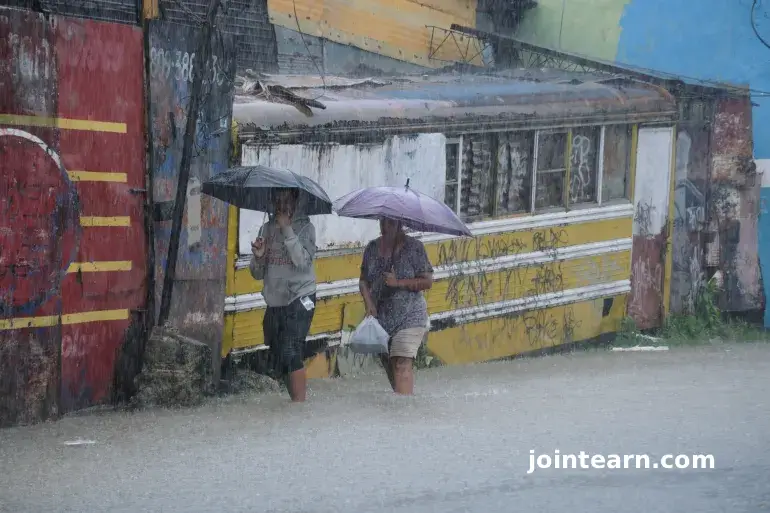
Forecasters warn that Hurricane Melissa could reach Category 5 strength before making landfall in Jamaica, bringing catastrophic rain, wind, and flooding to the Caribbean.
Caribbean on High Alert as Hurricane Melissa Intensifies
The northern Caribbean is on high alert as Hurricane Melissa rapidly intensifies into a Category 4 storm, unleashing torrential rainfall and life-threatening winds across the region. The hurricane, which has already claimed several lives in Haiti and the Dominican Republic, is expected to strengthen even further, potentially reaching Category 5 status as it barrels toward Jamaica.
According to the National Hurricane Center (NHC), Melissa was located about 200 kilometers (125 miles) south-southeast of Kingston, Jamaica, late Saturday, packing sustained winds of 185 km/h (115 mph). Forecasters warn that the storm could deliver catastrophic rainfall, flash floods, and mudslides across Jamaica, southern Haiti, and parts of the Dominican Republic.
Jamaica Prepares for Landfall: Government Activates Hundreds of Shelters
Jamaican authorities have issued urgent evacuation orders in flood-prone areas, activating more than 650 shelters nationwide. Prime Minister Andrew Holness urged citizens to take the storm seriously, warning that the country faces “one of the most severe weather threats in recent years.”
“I urge Jamaicans to take this weather threat seriously. Prepare your homes, safeguard your families, and follow official instructions,” Holness said in a national address.
The government confirmed that Norman Manley International Airport in Kingston will be closed until further notice, while Sangster International Airport in Montego Bay remains under review. Emergency warehouses have been stocked with thousands of food packages and medical supplies to ensure rapid relief distribution once conditions allow.
Meteorologists predict up to 76 centimeters (30 inches) of rainfall in some parts of Jamaica and southern Hispaniola, a deluge that could trigger catastrophic flash flooding and deadly landslides.
Haiti and the Dominican Republic: Early Damage and Rising Death Toll
Melissa’s slow, unpredictable path has already left a trail of destruction across Hispaniola, killing at least three people in Haiti and one in the Dominican Republic. Another person remains missing, authorities said.
In Haiti’s Sainte-Suzanne region, rivers have overflowed, destroying bridges and submerging roads. Local officials reported that hundreds of families have been displaced as water levels continue to rise.
“The storm’s slow movement is deeply concerning,” said Ronald Delice, a Haitian civil protection official. “We’re seeing flooding, food shortages, and growing fear in rural communities.”
In the Dominican Republic, nearly 200 homes were damaged, water systems were crippled, and over 500,000 people have been left without clean water. Widespread power outages, landslides, and isolated villages are compounding the crisis.
Cuba, Bahamas, and Turks and Caicos on Watch
As Hurricane Melissa continues its west-northwest trajectory, Cuba’s eastern provinces — including Granma, Santiago de Cuba, Guantánamo, and Holguín — have been placed under a hurricane watch. Authorities have started preemptive evacuations in low-lying coastal zones.
Meanwhile, the Bahamas Department of Meteorology warned that tropical storm or hurricane conditions could affect the Turks and Caicos Islands and parts of the Southeast and Central Bahamas early next week.
“Melissa’s slow movement means prolonged exposure to intense rainfall and high winds,” said Jamie Rhome, deputy director of the NHC. “For communities in its path, the situation is increasingly dire.”
Humanitarian Concerns: Floods, Food Shortages, and Infrastructure Collapse
The United Nations and regional relief agencies have expressed concern about the humanitarian impact of Hurricane Melissa, especially in Haiti, where fragile infrastructure and ongoing political instability have left millions vulnerable.
Heavy rains have already damaged roads, hospitals, and power lines, hampering rescue and relief efforts. Aid groups are rushing to preposition supplies in Port-au-Prince and Cap-Haïtien, though access to rural areas remains limited.
The storm has also disrupted agriculture, raising fears of food insecurity in a region still recovering from earlier storms this year.
Looking Ahead: Caribbean Braces for Prolonged Impact
Hurricane Melissa is the 13th named storm of the 2025 Atlantic hurricane season, which runs from June 1 to November 30. Experts say this season’s unusually warm Atlantic waters have contributed to rapid storm intensification, a growing concern for Caribbean nations already battered by climate change.
Forecasters expect Melissa to move slowly over the Caribbean for several days, before turning toward Cuba and the Bahamas later in the week. The storm’s unpredictable path and potential for further strengthening make it one of the most dangerous systems of the season.
Residents across the region are urged to stay tuned to official weather updates and emergency alerts as the situation evolves.
Leave a Reply